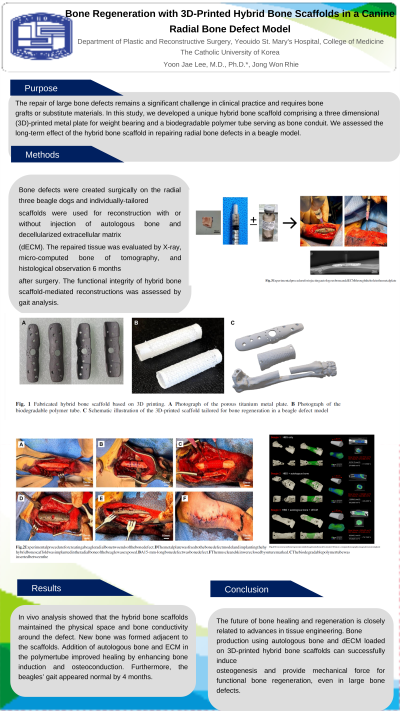Laboratory Research
(LR-012) Bone Regeneration with 3D-Printed Hybrid Bone Scaffolds in a Canine Radial Bone Defect Model

Jong Won Rhie, Professor
Introduction: The repair of large bone defects remains a significant challenge in clinical practice and requires bone grafts or substitute materials. In this study, we developed a unique hybrid bone scaffold comprising a three dimensional (3D)-printed metal plate for weight bearing and a biodegradable polymer tube serving as bone conduit. We assessed the long-term effect of the hybrid bone scaffold in repairing radial bone defects in a beagle model.
Methods: Bone defects were created surgically on the radial bone of three beagle dogs and individually-tailored scaffolds were used for reconstruction with or without injection of autologous bone and decellularized extracellular matrix (dECM). The repaired tissue was evaluated by X-ray, micro-computed tomography, and histological observation 6 months after surgery. The functional integrity of hybrid bone scaffold-mediated reconstructions was assessed by gait analysis.
Results: In vivo analysis showedthatthe hybrid bone scaffoldsmaintainedthe physical space and bone conductivity around the defect.New bonewas formed adjacenttothe scaffolds. Addition ofautologous bone and dECMinthe polymertubeimproved healing by enhancing bone induction and osteoconduction. Furthermore, the beagles’ gait appeared normal by 4 months.
Discussion: The future of bone healing and regeneration is closely related to advances in tissue engineering. Bone production using autologous bone and dECM loaded on 3D-printed hybrid bone scaffolds can successfully induce osteogenesis and provide mechanical force for functional bone regeneration, even in large bone defects.
Trademarked Items:
References:
Methods: Bone defects were created surgically on the radial bone of three beagle dogs and individually-tailored scaffolds were used for reconstruction with or without injection of autologous bone and decellularized extracellular matrix (dECM). The repaired tissue was evaluated by X-ray, micro-computed tomography, and histological observation 6 months after surgery. The functional integrity of hybrid bone scaffold-mediated reconstructions was assessed by gait analysis.
Results: In vivo analysis showedthatthe hybrid bone scaffoldsmaintainedthe physical space and bone conductivity around the defect.New bonewas formed adjacenttothe scaffolds. Addition ofautologous bone and dECMinthe polymertubeimproved healing by enhancing bone induction and osteoconduction. Furthermore, the beagles’ gait appeared normal by 4 months.
Discussion: The future of bone healing and regeneration is closely related to advances in tissue engineering. Bone production using autologous bone and dECM loaded on 3D-printed hybrid bone scaffolds can successfully induce osteogenesis and provide mechanical force for functional bone regeneration, even in large bone defects.
Trademarked Items:
References:

.png)